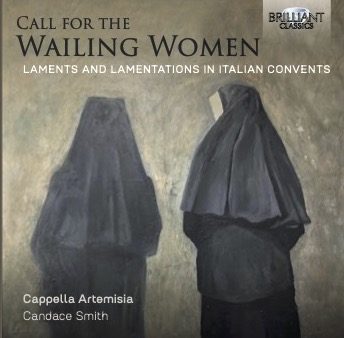A new CD from the Cappella Artimisia featuring the Nuns of Barga painting of Suor Carmelina by Keane – more on those nun paintings here
Throughout the late 16th and 17th centuries, the chronicles of historians and travellers in Italy provide images of a fabulous musical world inhabited by women – singers, players and even composers. Such images are all the more intriguing, considering the truly draconian restrictions governing virtually every aspect of these cloistered women’s lives, especially their music. Moreover, a veil of mystery surrounds this repertoire: the music written by and for the nuns often includes parts for tenor and bass voices, and the use of instruments was officially forbidden in the convents.
How was this music performed?
Cappella Artemisia is an ensemble of female singers and instrumentalists that attempts to provide some answers to this question.
Dedicated to performing the music from Italian convents in the 16th and 17th centuries, its repertoire includes both forgotten works composed by the nuns themselves, as well as music intended for performance in the convents by better-known male composers, but presented here for the first time as it would originally have been heard, i.e., without male voices.
Call for the Wailing Women: Laments and Lamentations in Italian Convents
The Lament has been associated with women since time immemorial. From the book of Jeremiah to Ovid’s Heroides to Mediterranean folk traditions, mournful weeping has long been the prerogative of women. Moreover, the lament was a socially acceptable outlet for female eloquence in a society and a Church that instead dictated silence and subjugation.
This recording presents laments and lamentations from 16th- and 17th-century Italy as they might have been heard in that most exclusively female environment: the convent. It includes works composed both by and for cloistered nuns, and features a number of different settings, both monodic and polyphonic, of the very expressive text of the Lamentations of Jeremiah.
This program, featuring nine voices, violin and basso continuo (15 musicians), presents the exquisitely female genre of the lament within the context of the female world of the convent, and it explores though music the many roles open to women’s voices: mother, bride, nun, artist.
Un nuovo CD della Cappella Artemisia con in copertina il dipinto di Suor Carmelina – The Nuns of Barga di Keane – maggiori informazioni su quei dipinti delle monache qui.
Nel tardo XVI e nel XVII secolo, le cronache di storici e viaggiatori in Italia ci restituiscono l’immagine di un mondo musicale straordinario abitato da donne – cantanti, strumentiste e persino compositrici. Queste immagini risultano tanto più affascinanti se si considerano le restrizioni realmente draconiane che regolavano praticamente ogni aspetto della vita di queste donne claustrate, in particolare la loro musica. Inoltre, un velo di mistero avvolge questo repertorio: la musica scritta dalle e per le monache spesso include parti per voci di tenore e basso, e l’uso degli strumenti era ufficialmente proibito nei conventi.
Come veniva eseguita questa musica?
Cappella Artemisia è un ensemble di cantanti e strumentiste che cerca di offrire alcune risposte a questa domanda.
Dedicato all’esecuzione della musica proveniente dai conventi italiani del XVI e XVII secolo, il suo repertorio comprende sia opere dimenticate composte dalle stesse monache, sia musiche destinate all’esecuzione nei conventi da parte di compositori uomini più conosciuti, ma presentate qui per la prima volta così come sarebbero state originariamente ascoltate, ovvero senza voci maschili.
Call for the Wailing Women: Lamenti e Lamentazioni nei conventi italiani
Il lamento è associato alle donne da tempo immemorabile. Dal Libro di Geremia alle Heroides di Ovidio, fino alle tradizioni popolari mediterranee, il pianto dolente è da sempre prerogativa femminile. Inoltre, il lamento rappresentava una valvola di sfogo socialmente accettabile per l’eloquenza femminile in una società e in una Chiesa che invece imponevano silenzio e sottomissione.
Questa registrazione presenta lamenti e lamentazioni dell’Italia del XVI e XVII secolo così come potrebbero essere stati ascoltati in quell’ambiente esclusivamente femminile: il convento. Include opere composte sia dalle monache sia per le monache, e propone diversi arrangiamenti, sia monodici sia polifonici, del testo altamente espressivo delle Lamentazioni di Geremia.
Questo programma, che coinvolge nove voci, violino e basso continuo (15 musiciste), presenta il genere squisitamente femminile del lamento nel contesto dell’universo femminile del convento, ed esplora attraverso la musica i molti ruoli aperti alla voce delle donne: madre, sposa, monaca, artista.





